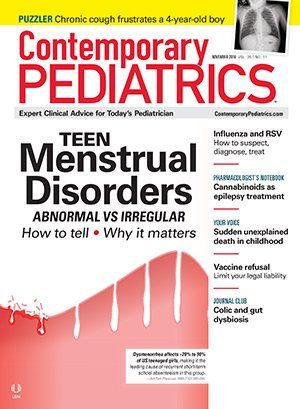Staggering consequences of front-end healthcare cost cutting
For children living below the federal poverty level, public insurance programs are a lifeline to crucial healthcare services. If eligibility requirements change, however, thousands of children could be left without healthcare-a move that could result in billions of dollars’ worth of uncompensated care for hospitals each year.
Jessica L. Bettenhausen, MD, FAAP

When faced with budget shortfalls, policymakers often consider reducing funding of healthcare programs. However, a new report reveals that cutting spending on children’s health programs by changing eligibility requirements could have significant consequences.
The report, published in Pediatrics, found that lowering eligibility requirements for public insurance (Medicaid and the Children’s Health Insurance Program (CHIP)) to 100% of the poverty level-current eligibility thresholds of the 14 states studied ranged from 152% to 405% of the federal poverty level-would leave an estimated 650,000 hospitalized children without public insurance coverage.1
Nationally, more than 30 million children are covered by public health insurance programs. Public insurance programs are funded jointly between states and the federal government, and the federal share varies between 50% and 70% by state, according to the report. Any push to limit federal spending on healthcare may result in states tightening the belt on public insurance programs. Although this might save some upfront tax dollars, the study authors estimate that these newly ineligible healthcare expenses for these children would end up costing the families, commercial insurance (if families could afford coverage), or the healthcare system more than $4 billion per year.
“Public insurance eligibility limits for children vary by state, but nearly all are higher than 200% of the federal poverty limit,” says Jessica L. Bettenhausen, MD, FAAP, pediatric hospitalist in the Department of Pediatrics, Children’s Mercy Hospital Kansas City and University of Missouri-Kansas City School of Medicine, Kansas City, Missouri, and lead author of the study. “If eligibility limits were decreased to 200% of the federal poverty limit, over 60% of all hospitalizations currently covered by public insurance would be newly ineligible, affecting 412,000 children in 14 states.”
Data reveal a bigger problem
Researchers used data from the Agency for Healthcare Research and Quality’s State Inpatient Databases (SID), examining hospitalization costs from children aged younger than 18 years across 14 states whose healthcare costs were primarily paid through Medicaid and CHIP. The children included in the study represented 30.6% of American households: 43.1% lived below 300% of the federal poverty level; 27.2% lived below 200% of the federal poverty level; and 11.2% lived below 100% of the federal poverty level, according to the report. Six of the states studied already had set public insurance eligibility requirements at 300% of the federal poverty level.
As far as demographics, 38% of the publicly insured children studied were non-Hispanic white, 20.2% were African American, and 24.5% were Hispanic. Most of the children across all ethnicities lived in urban areas.
The study team examined the healthcare costs of these patients using 3 different federal poverty level eligibility thresholds-100%, 200%, and 300%. Of the more than 775,000 hospitalizations of publically insured children analyzed in the report, researchers estimate that greater than 45% would be ineligible for reimbursement using a 300% of federal poverty level threshold. Additionally, more than 60% would be ineligible for reimbursement using a 200% threshold, and upwards of 80% would be ineligible for reimbursement using a 100% of federal poverty level threshold, according to the report.
Although cutting federal spending on public insurance programs may seem like a good solution to save the dollars spent on healthcare, the researchers note that these costs would be shifted to low-income families, commercial insurance (if obtainable by families), or hospitals, totaling $1.2 billion annually with a 300% threshold, $3.1 billion with a 200% threshold, and $4.4 billion with a 100% of poverty level eligibility threshold.
Cuts at what cost?
The impact of increases in unreimbursed care is dependent upon families being able to afford commercial coverage, but at these levels, it may mean huge losses for hospitals, particularly safety-net hospitals that serve low-income patients and that already operate with narrow margins or at a loss, the authors point out.
“Reducing public insurance eligibility limits would have resulted in numerous pediatric hospitalizations not covered by public insurance, shifting costs to families, other insurers, or hospitals,” the authors write in the report. “Without adequately subsidized commercial insurance, this reflects a potentially substantial economic hardship for families and hospitals serving them.”
Medicaid now spends about $100 billion each year on healthcare services for children, according to the study. Without aid programs, families would have to be responsible for the costs that they might not be able to afford; hospital systems would have to absorb the costs; or children would simply go without the care they need.
“Pediatricians acting as child health advocates at the local, state, or national level influence policy for all children,” Bettenhausen says. “All pediatricians have the experience and perspective to provide expert testimony on the importance of access to adequate healthcare for children.”
Pediatricians should also make referrals as necessary to patients and their families at risk of losing public insurance, pointing them in the direction of someone who can help the family navigate subsidized insurance options, she adds. Even subsidies may not help some families, however, and Bettenhausen says she hopes the study will highlight the consequences of severe cuts to public insurance programs for children.
“If families with children who are newly ineligible for public insurance are unable to obtain commercial insurance, they would be confronted with a very difficult decision-either choosing between forgoing necessary healthcare or jeopardizing the economic well-being of the family,” she says.
Bettenhausen says the study should be a call to action for both policymakers and pediatricians.
“We hope that this article encourages policymakers to consider the individual effects of health policy, and pediatricians to consider their role as a child health advocate on a broader scale,” she says. “As pediatricians, we understand that the provision of healthcare during childhood improves health across the life course, and investment in child health returns dividends over time. Though this study focuses on hospitalized children, access to high-quality outpatient care is equally important. Ensuring that all children have equal access should not be understated.”
References:
1. Bettenhausen JL, Hall M, Colvin JD, Puis HT, Chung PJ. The effect of lowering public insurance income limits on hospitalizations for low-income children. Pediatrics. 2018;142(2):e20173486. Epub July 9, 2018.

Newsletter
Access practical, evidence-based guidance to support better care for our youngest patients. Join our email list for the latest clinical updates.